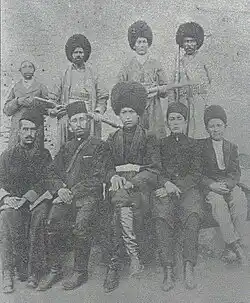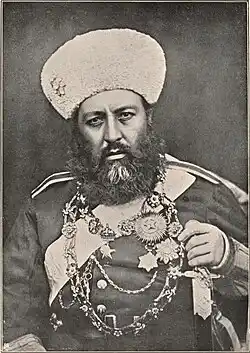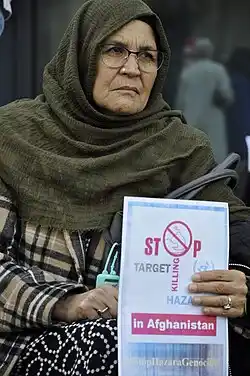
The persecution of Hazaras refers to the discrimination, violence towards and attempted genocide of the Hazara people over the last century and a half. This has primarily taken place in Afghanistan, though violence against Hazara groups has also occurred in the Baluchistan region of Pakistan. The exact sociological reasons for this are not entirely clear. The Hazaras only emerged as a distinct group within the Mughal Empire in the sixteenth century and they share some ethnic similarities with the Turkic and Mongol peoples of Central Asia. Therefore the persecution they have experienced would seem to be primarily owing to their adherence to Shia Islam in contrast to the predominantly Sunni Islam Afghanistan. A major campaign of persecution against the Hazaras occurred in Afghanistan between 1888 and 1893. More recently, the Hazara minority within Pakistan have experienced persecution in the 2000s and 2010s and in Afghanistan since the return to power of the Taliban in 2022. The persecution of this group has led to many migrating and seeking asylum abroad.[1]
Research your ancestors on MyHeritage
Persecution of Hazaras chronology of eventsPersecution of Hazaras chronology of events
The exact ethnic background of the Hazaras, and the mechanism whereby they came to be considered a distinct people within Central Asia, has never been entirely explained. This is not a wholly unusual development. There are groups even within Europe, such as the Traveller community within Ireland, whose ethnic background is unclear. Genetic tests and other scientific methods have determined that the Hazara do have a significant amount of both Turkic and Mongol heritage from when the Turks came through and settled much of Central Asia from the eighth century onwards and when the Mongols dominated here between the thirteenth and sixteenth centuries.[2]
It was towards the latter end of the Mongol dominance, in the sixteenth century, as the Timurid Empire expanded south out of Afghanistan to conquer Pakistan and northern India, transforming into the Mughal Empire in the process, when the Hazaras first clearly emerged as a distinct group within the region.[3] Thereafter they became more readily distinguishable from the other peoples of Afghanistan and Pakistan on account of their particular cultural and social habits, most notably their adherence to Shia Islam in contrast to the Sunni majority in Afghanistan.[4]

It was primarily owing to their religious stance that the Hazaras began to experience major persecution within the Emirate of Afghanistan in the last quarter of the nineteenth century. This came about as a consequence of the centralizing policies of Abdur Rahman Khan, who united Afghanistan under his rule. Hazara efforts to resist the appropriation of their land and redistribution of it to Sunni Muslims and supporters of the Khan resulted in a campaign of brutal persecution which amounted to attempted genocide. The scale of this is hard to determine, as the first full modern census was not carried out in Afghanistan until 1979 and there are few demographic records with which to determine the extent of the murder involved. Historians tend to believe that several hundred-thousand Hazaras were killed in the persecution between 1888 and 1893, amounting to over half the total Hazara population within Afghanistan at that time.[5]
The Hazaras continued to experience periodic bouts of persecution in the century that followed. For instance, under the otherwise relatively tolerant reign of Mohammad Zahir Shah between 1933 and 1973, an uprising occurred amongst the Hazara in 1945 in response to the imposition of a special tax on them by the government. More serious has been the persecution of the Hazara people by the Taliban, both during their first period in power in the 1990s and early 2000s after the Soviet-Afghan War and again since they reclaimed control over Afghanistan in 2022.[6] Furthermore, the large Hazara community in the city of Quetta, capital of the province of Baluchistan in Pakistan, has suffered continuous terrorist attacks by Sunni extremist groups like Lashkar-e-Jhangvi and Islamic State since 2001, fueled by the refugee crisis created by the invasion of Afghanistan by the United States.[7]
Extent of migration associated with the persecution of HazarasExtent of migration associated with the persecution of Hazaras
The persecution which the Hazara people have experienced since the nineteenth century has led to the mass migration of millions of people. Many began crossing the border southwards into what was then the British Raj, creating a large Hazara minority there, the legacy of which is still tangible in Pakistan and India today. Others moved westwards into Iran (then Persia) and the Russian Empire (now states like Kazakhstan and Uzbekistan). Internal migration also took place as Hazaras within Afghanistan sought to live in more clustered blocks for security in numbers. Similar patterns of migration have continued down to the present day when Hazaras have experienced persecution, though many have travelled further afield in the twentieth and early twenty-first centuries.[8]
Demographic impact of the persecution of HazarasDemographic impact of the persecution of Hazaras

Beyond Central Asia itself, the demographic impact of the Hazara diaspora has been felt to the greatest extent in a number of European countries, above all in Germany, where there are well over 300,000 Hazara people living today. Approximately 50,000 have made a new life in Sweden, while Austria, Turkey, the United Kingdom and the Netherlands have also taken in a substantial enough number of Hazara refugees over the years. There are only around 10,000 Hazara people in Afghanistan compared with over 40,000 in Australia. However, by far the largest element of the Hazara diaspora is in Iran, where Hazaras have been migrating since the middle of the nineteenth century to live amongst their Shia co-religionists. There are an estimated three million Hazara people in Iran today, many of the descendants of people who have crossed into that country at various times since the late nineteenth century.[9]
See alsoSee also
Explore more about the persecution of HazarasExplore more about the persecution of Hazaras
- The Hazaras of Central Afghanistan on JSTOR
- The Hazaras of Central Afghanistan in Mughal Times on JSTOR
- The Plight of Hazaras Under the Taliban Government at The Diplomat
References
- ↑ Mehdi J. Hakimi, ‘The Afghan State and the Hazara Genocide’, in Harvard Human Rights Journal, Vol. 37 (2023).
- ↑ https://www.sciencedirect.com/science/article/abs/pii/S1872497317301461
- ↑ Farha Samreen, 'The Hazaras of Afghanistan in Mughal Times', in Proceedings of the Indian History Congress, Vol. 70 (2009/2010), pp. 821-829.
- ↑ https://euaa.europa.eu/country-guidance-afghanistan-2023/3142-individuals-hazara-ethnicity-and-other-shias
- ↑ https://encyclopedia.pub/entry/37989
- ↑ https://www.ushmm.org/genocide-prevention/blog/urgent-action-needed-hazaras-in-afghanistan-under-attack
- ↑ https://www.theguardian.com/global-development/2021/apr/05/mass-graves-pakistan-shia-minority-hazara-slaughter-imran-khan
- ↑ https://www.unhcr.ca/news/persecution-perseverance-survival-stories-hazara-community/
- ↑ https://iranprimer.usip.org/blog/2021/jul/28/iran-afghanistan-and-taliban

